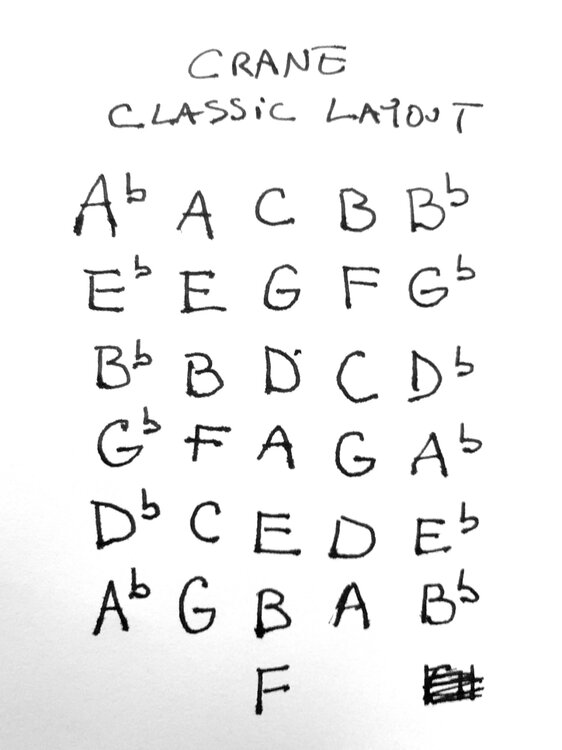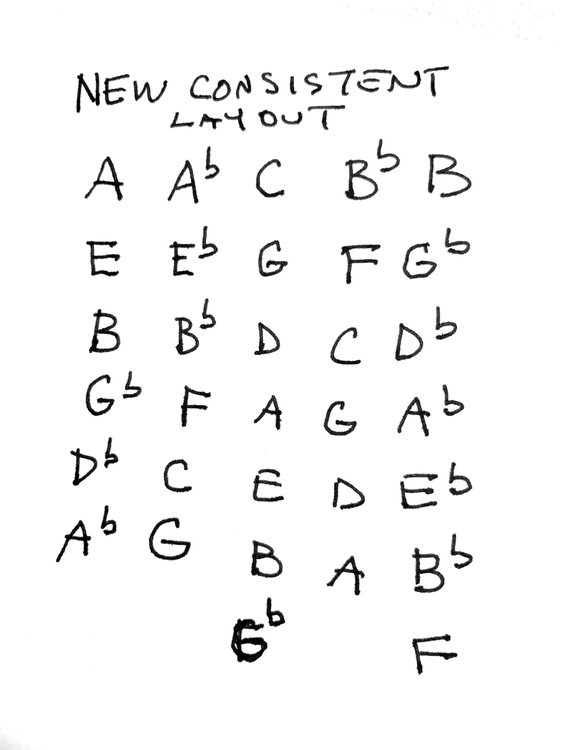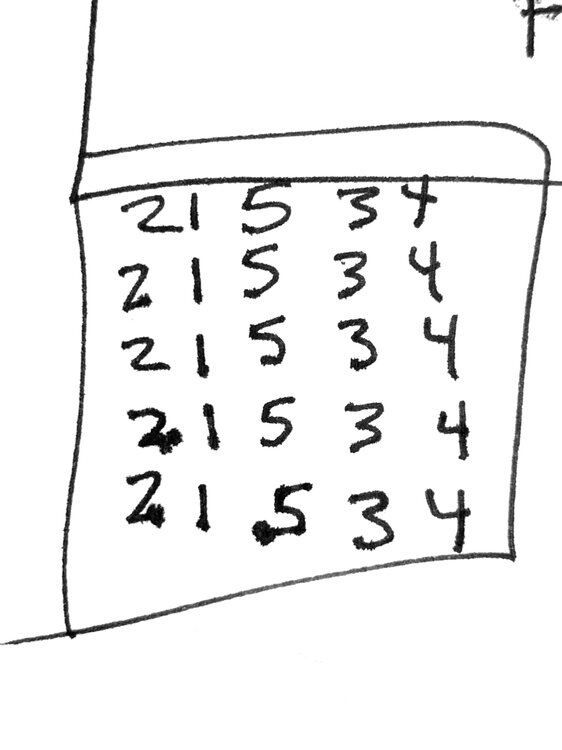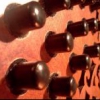Search the Community
Showing results for tags 'fingering'.
-
Hi, my name is Eric. I’m a novice crane duet player, who is working on music theory and learning to play my instrument. I’ve seen discussions about moving notes around on the crane. And did a layout to see what it would look like. I’m assuming that the crane layout was created to make life easier for people who didn’t use many sharps or flats. Since the sharps and flats are on the outside. But there was a discussion someplace on concertina.net about different layouts. I could not get it out of my head as I’m studying theory a bit and realize how much counting is to be done to figure out chords. so I thought I’m make a chart to see what it looked like and saw that if it’s possible to re-order the keys so that it’s always consistent on each column. It seems to me, then, that the new layout would keep all the chord fingerings the same? is this a more logical system according to theory? To have the same pattern ? e.g. the note above is always a perfect 4th. The chords fingering patterns would be consistent on each column. Are there other systems with the same layout? has anyone re-ordered the reeds in their crane to do this? (Im assuming this could be done by just moving the reeds? Is that true?) would this make music theory easier repositioned this way? looking forward to hearing thoughts. 3 photos attached. first is how it is on my crane. second is how the notes would be repositioned. third shows the consistent patterns of semitones going up the rows. (Also- my box is already a bit unusual in that it goes down to F on each side.) Best, Eric
- 9 replies
-
- crane duet
- theory
-
(and 1 more)
Tagged with:
-
Greetings -- I'm a concertina newbie, just bought a Stagi 46 note (I know, I know, the concertina all love to hate, nevertheless, I like the sound, system and esp the price ? ). I was playing around with the strap tightness/looseness, and it suddenly occurred to me that no matter how I adjusted it, it still seemed awkward to reach some notes from some others. Then I thought what if really loosen it up and put all my fingers through, and when I did I realized I'd gained 25% more fingers (20% more if one is bad at math, so let's split the difference and call it 22.5%). Of course, the part of the back of hand that makes contact with the strap for bellowing is closer to the wrist, and resting each end of the concertina on the corresponding leg may be needed for stability given the looser straps and not using the thumbs for stability. Having all 10 fingers then permits easier interval stretches and more fingering options for both melodies and chords. I do allow for the possibility that as a newbie, I simply don't realize this is ridiculous, scandalous and will never work as I progress, but just wondering, does anyone out there use their thumbs to play concertina?
-
I posted the text below elsewhere. However, I thought that it might attract further discussion by being posted on its own. It concerns the question of whether to finger consecutive notes on C# and F# on the English concertina using fingers 1 & 2 or 2 & 3 (two-finger rolls by Simon Thoumire's terminology ?). In a jig on the English moving across to the lower F# on the right, for example, the two-finger roll technique to play a triplet (three consecutive notes on the same button) implies using fingers 1 & 2 all the time, yet this requires one to travel quite some way across the finger board. I've given a sample. It's a decoration, of course, but one that I wish to conquer. When attempting this with fingers 2 & 3 it feels much weaker and slower. There are, in fact, four F# notes to negotiate in this, so there is the problem of how to ensure that one's fingers fall on the buttons in the correct order. Looking forward to suggestions as to how to overcome this difficulty.
-
Hello, I'm confused about the way you learn a tune and add the chords. I'm painstakingly trying to remember the chords (and so also have to understand the different keys), that's one thing. My problem is more with fingers... For me adding anything out of the melody line means re-learning a different fingering. For simple tunes probably not, and even less so with simple octaves... but what about complicated pieces? For example I'm working on a classical piece and my fingers, all four of them, are already all over the place! High E can be played by four different fingers...I sometimes had to write down which finger went where to make sure I could continue the phrase. So what does this mean? Will I have to learn everything twice, with two different fingering? Or do I have to be so good that I can already imagine the fingers I'll need in the future? Or so comfortable that really it doesn't matter where my fingers are (actually I can see that happening at some point). I apologize if my formulation is unclear. I've already written five or six messages that I never posted because I wasn't even sure of what I was asking... --------------------------------------------------------------------------------------------- FYI I have a Jackie and high notes are much much weaker than the other notes. A lot of advice has already been given to me on this forum - but it takes its own route in my brain. Things that I mentally thought were great hadn't sunk in, then resurface later and it clicks "yeah, that's what I have to do!". I'm confident it will be the same with chords. PS: I want to work on this chording/accompanying/enriching the melody...I've seen videos of Danny Chapman (Prof Rat on youtube) and he made me think that maybe I didn't need to try the duet system after all
- 6 replies
-
- fingering
- finger position
-
(and 1 more)
Tagged with:
-
Looking for thoughts about making Irish tunes sound "more Irish". Does changing bellows direction on every note, or every other note make a difference...as opposed to playing several notes on a draw or push? Emphasizing the first note in a measure? Any other tips? Thanks! I'm playing a C/G Anglo.
-
Hi all, I am wondering what might be the best way to play the triplet (B C# D) in the Sligo Maid: https://thesession.org/tunes/399 I am playing an Anglo C/G with double C#s on the first button, top row, right hand. If I play all 3 on the draw (RH) it isn't smooth, nor is it if I push(LH, RH, LH). I'm not sure if it is just that I'm not good/fast/practiced enough, or what. Any thoughts? Thanks, Susan
-
I've been looking over the chart for English concertina fingering as given here: http://www.concertina.com/fingering/ The first chart, English Concertina Keyboard -- http://www.concertina.com/fingering/images/english48-W842H736.gif has me wondering why it's shown as starting an octave above Middle C. This isn't 'wrong' but I can't figure out if it's actually 'correct' and I would in fact be somehow wrong to show the chart with the lowest C being notated with a capital C, not the small c. So, I would have started with the low G being lower, notated as G, -- then continue up going G#, Ab, Bb, B, C -- etc --- simply an octave lower than it's given on the chart. Sound-wise, the chart is more correct, maybe? But as far as what I'd want to read or write on the musical staff, I think I'd want to go with the lower octave start. Am I missing something...?
-
So I recently learned the Foxhunters in A, so obviously there's gonna be that pesky g# in the 4th part. How do you anglo players handle that? avoid it? change fingering positions? play a different note. Take your 'tina to the shop to have a g# installed where it's easier to reach, to the tune of $$$, just so you can play that one reel? Me?--I either play the b above the a, instead of the g#, or I 'll sometimes play the f# below the a. I have to play real slooooow to even hope to get up to the g# in standard position, and I haven't really tried changing positions yet. In G, Foxhunter's is much more concertina friendly. I do like it in A though, really slamming that c# is alot of fun, twisty fingering notwithstanding. (edited to correct spelling.)
- 18 replies
-
- fingering
- foxhunters
-
(and 1 more)
Tagged with:
-
I am a new concertina player and am mostly teaching myself with the help of various DVDs, CDs and tutorial books. I LOVE the tune "Glasgow Reel" (aka Tamlin) and though I have the sheet music for it, it seems pretty tricky on my C/G Anglo. Am I foolish to try to learn this???? Any suggestions??? Thanks, Susan






